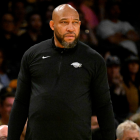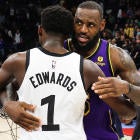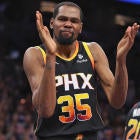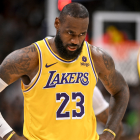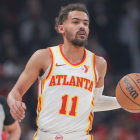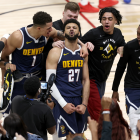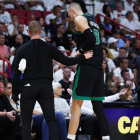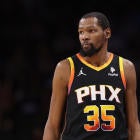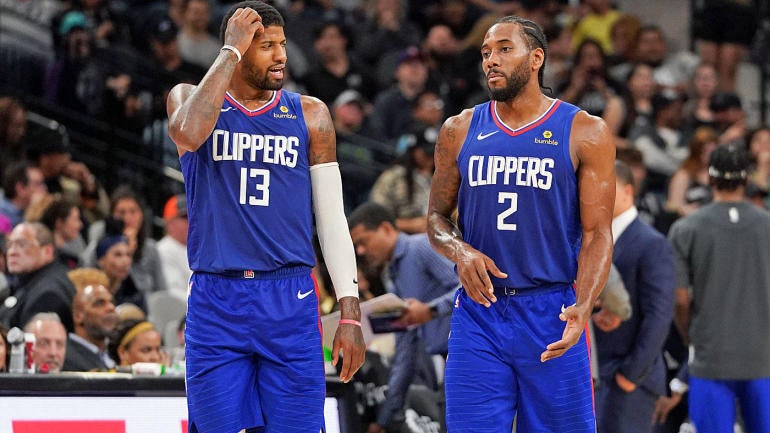
One of the biggest mistakes NBA teams routinely make is building for the past instead of the present. The Houston Rockets are notorious offenders. Their micro-ball lineup would have worked wonders against the Golden State Warriors... but the Warriors were no longer their competition for the championship. As we later found out, the Lakers were, and Houston's gambit failed because of how ill-equipped it was for Anthony Davis' size.
Quietly, the Clippers fell for the same fallacy. They looked at the league that the Warriors left in their wake and decided that traditional positional roles were meaningless. They assumed that Kawhi Leonard, a small forward, could function as a primary ball-handler, and that center defense was a luxury as long as they were strong enough at the point of attack. It wasn't just that their two best players were wings. Functionally, even their non-wings were, essentially, wings. Patrick Beverley and JaMychal Green functioned as switchable shooters, not traditional archetypes for their positions. At the trade deadline, they cashed in their only chip (their own 2020 first-round pick) for another wing in Marcus Morris rather than a point guard or a center.
You can blame Montrezl Harrell's playing time for the Clippers' loss, or poor chemistry, or any number of other valid flaws, but the broad explanation here is that the Clippers were rigid and predictable. Most of their players did basically the same things, and when the Nuggets figured out how to stop those things, they didn't have a roster capable of countering. They might not have needed to in a season featuring only the Warriors as co-contenders, but as the Rockets found, 2020's playoff field was so varied that surviving it required adaptability that they didn't have. The Lakers did. That's why they're the champions right now.
It's what the Clippers need to match this offseason, and it will be an enormously difficult balancing act. The Clippers need to diversify their roster without sacrificing what made it special in the first place, and they need to do so through a fairly limited set of team-building tools. The Clippers don't have a single tradeable first-round pick. Major free-agent activity would require sacrifices. But their talent alone guarantees that a pathway to the championship exists for the Clippers. This offseason preview will try to find it.
One note before beginning: we will be using Spotrac for player salaries, and 2019-20 cap numbers for this exercise as a whole. That includes previously agreed-upon numbers like the rookie scale and the minimum salary. A frozen cap is the likeliest outcome of negotiations between the league and the NBPA, but these numbers could theoretically change in either direction. Under the assumption that the 2019-20 numbers will be used, these are the pertinent numbers for these projections.
Salary cap | $109,140,000 | Non-Taxpayer Mid-Level Exception (Year 1) | $9,258,000 |
Luxury tax | $132,627,000 | Taxpayer Mid-Level Exception (Year 1) | $5,718,000 |
Luxury tax apron | $138,928,000 | Cap room Mid-Level Exception (Year 1) | $4,767,000 |
Salary floor | $98,226,000 | Bi-Annual Exception | $3,623,000 |
Cap situation and overall finances
The Lakers and Clippers took very different paths to max cap space in 2019. The Lakers cleared the decks almost entirely, and as a result, were able to build flexibility into their roster on a year-to-year basis. The Clippers went the other way. They built a cohesive team with the idea that a star or two could be dropped easily into it. That, in large part, is why the Clippers were favored over the Lakers for most of the season. The Lakers were supposed to need time to build a championship-caliber roster. The Clippers, in theory, already had one.
That's obviously not how things played out, and that makes things significantly harder for the Clippers. They were built to win right away, with each progressive championship getting harder and harder to earn given everything they gave up to build their supposed juggernaut. The Clippers have little to trade, and some of the role players they either had in place before Kawhi Leonard and Paul George joined or acquired after the fact are now due new contracts. As it stands right now, the Clippers are well above the cap and a near-lock to pay the tax.
Salary cap | $109,140,000 | Non-Taxpayer Mid-Level Exception (Year 1) | $9,258,000 |
Luxury tax | $132,627,000 | Taxpayer Mid-Level Exception (Year 1) | $5,718,000 |
Luxury tax apron | $138,928,000 | Cap room Mid-Level Exception (Year 1) | $4,767,000 |
Salary floor | $98,226,000 | Bi-Annual Exception | $3,623,000 |
*player option
**non-guaranteed
Cap space is out of the question here. The number worth watching is the apron. If the Clippers want to add a starting-caliber player in free agency, they will probably have to use the Non-Taxpayer Mid-Level Exception. That adds around $9,258,000 million to their ledger and hard caps them at that apron number of $138,928,000. With their current committed salaries, they would have only $13,888,323 left to spend on the entire rest of the roster. That might not be enough to keep either Marcus Morris or Montrezl Harrell, and certainly isn't enough for both. Normal teams might attach draft picks to dump some salary, but the Clippers only have second-round picks to offer in an environment with very little cap space to move a player like Rodney McGruder into. In all likelihood, that means the full Mid-Level Exception is going to cost the Clippers either Morris or Harrell.
For a variety of reasons, Morris is the preferable keeper. His skill-set is significantly harder to find on the market, whereas a reasonable facsimile of Harrell's rolling can usually be found for the minimum. He gives them lineup optionality as a small-ball 3-and-D center against opponents not built to combat that. He is also, frankly, the better player, and an easier sell to a locker room that Harrell did not seem thrilled to be a part of last season.
The problem is that Morris will likely have more suitors than Harrell, and whereas the Clippers have full Bird Rights on Harrell and can therefore offer him any amount of money allowable under the cap, they have only Non-Bird Rights on Morris, limiting him to a 120 percent raise. That's an $18 million limit in the first season of a new deal. Cap space teams can exceed that. A few might try, but the standout suitor here is the Knicks, who have practically unlimited cap space to work with. Morris started last season in New York on a one-year deal and said openly that he wanted to remain there. The Knicks may be amenable. He played the best basketball of his career as a Knick and fits fairly well alongside their young talent. More importantly, veterans who want to be Knicks are in short supply. Morris could be a great public relations vehicle for a regime desperate for some good press. If Morris leaves, the Clippers almost have to retain Harrell merely as an asset play.
Now, there is a scenario in which the Clippers could keep both. If they choose to use the smaller Taxpayer Mid-Level Exception, they won't be hard-capped and can throw around Steve Ballmer's cash however they see fit. There is a real argument in favor of this path. Three good players are better than two. Keeping Morris and Harrell allows the Clippers to potentially trade them later. And in such a bad financial market, some of their targets might be just as willing to accept $5.7 million as they would $9.3 million, depending on what else is out there.
And that is the ultimate question at play here: what can the Clippers get for the Non-Taxpayer Mid-Level Exception, and is it worth sacrificing Morris or Harrell? The answer is... maybe. The Clippers have two primary needs to consider with that slot. The first is a point guard, as the Clippers finished 28th in total passes last season and 22nd in assists. Leonard has grown significantly as a passer, but he can't run an offense by himself. The second need, as demonstrated by Nikola Jokic, is a better low-post defender at center, ideally one that won't hurt the offense. There are options on both fronts:
- Only one point guard on the market is worthy of the full Mid-Level Exception, but he'd be a bargain at that price. Goran Dragic is going to be sought after by virtually every Mid-Level team, and the Heat would love to keep him. It just isn't clear how far they're willing to go to do so, especially with an eye on max cap space in 2021 for Giannis Antetokounmpo. The likeliest outcome here is a massive one-year offer from Miami in the neighborhood of $20 million. The Clippers could offer over $40 million on a four-year deal. Does Dragic, at 34 and after an injury cost him a chance to win a championship, trust himself enough to wait an extra year before his free-agent windfall? Taking that one-year offer would be a high-risk, high-reward decision. The Clippers have security to offer. If Dragic is off of the table, D.J. Augustin makes some sense for the Taxpayer Mid-Level. So does Rajon Rondo, as the Clippers can afford to wait out his regular-season woes so long as he brings it in the playoffs as he did for the Lakers.
- There has never been a better year to spend the Mid-Level Exception on a center than 2020. If the Clippers want a drop-coverage big that can hang in the post and both shoot and pass on offense, Marc Gasol and Aron Baynes are both available. Derrick Favors offers a slightly burlier option if they're willing to forego some space. If they want someone a bit more mobile, Tristan Thompson fits the bill and could replace Harrell's rolling, and Serge Ibaka adds even more shooting. The smaller Taxpayer Mid-Level would at least be able to get them someone like Mason Plumlee, a workable backup who at least has a bit of inside information on Jokic.
- On the off chance Morris leaves, the Clippers could pivot and bring back the player they traded for him: Mo Harkless. He is destined for somebody's Mid-Level Exception, though given their other needs, this may not be advisable.
- The Clippers will be a desirable destination for veteran ring-chasers willing to play for the minimum. Shooting will be prized here, as Ty Lue's Cleveland teams tended to shoot far more than Rivers' Clippers. Kyle Korver is an obvious target given his connection to Lue in Cleveland.
In a perfect world, the Clippers would keep Morris and Harrell and just hope that one of their targets is willing to leave some money on the table. That's hardly an impossibility. There are so many centers that one of them is probably going to end up losing the game of financial musical chairs. Maybe the Heat decide to pivot off of their own free agents and spend their cap space elsewhere and a market doesn't develop for Dragic. If the Clippers can avoid committing as long as possible, they probably should.
But ultimately, if sacrificing Harrell means getting Dragic or Baynes or Gasol, that's probably a worthwhile move. Finding a Harrell replacement for the minimum is feasible. Technically, it might not even be necessary. If the Clippers use the Non-Taxpayer Mid-Level Exception, they can also use the Bi-Annual Exception, as it comes with the same hard cap. Cash concerns might be meaningful here, but there's a workaround. The Bi-Annual Exception is worth up to $3,623,000. The Clippers could use the stretch provision on McGruder, who hardly played last season, to save almost all of that, $3,461,538. It would just mean paying his $5.2 million over three years instead of one. Dead money won't mean much to a Clippers team unlikely to use cap space in the near future anyway. In that sense, letting Harrell go might give the Clippers access to two meaningful free agents, not just one. That's another point in favor of that strategy. Their strategy will wind up being dictated by what else they can do this offseason, and it's unclear what they can put on the table from a trade perspective given their lack of draft capital.
Draft capital
2020 picks: No. 57
Owed future first-round picks: 2022 to OKC (unprotected), 2024 to OKC (unprotected), 2026 (unprotected)
Owed pick swaps: 2021 to NYK (top-four protected), 2023 to OKC (unprotected), 2025 to OKC (unprotected)
You're not reading this wrong. The Clippers do not control their own first-round pick until 2028. The Stepien Rule prevents teams from being without a first-round pick for consecutive seasons, and since the Clippers owe picks in 2022, 2024 and 2026 and no picks can be traded more than seven years before they are made, they don't have a single first-round pick that can be dealt. They have one meaningful incoming second-rounder from Detroit, but otherwise, it's only their own, presumably late picks.
No. 57 is functionally no different than signing an undrafted free agent, but the Clippers should be able to buy another second-round pick from a cash-strapped team higher in the round. As second-round picks aren't governed by the rookie scale, the Clippers would probably like to do this just to give themselves a worthwhile prospect playing for the rookie minimum salary. That's a difference of roughly $700,000 compared to the veteran's minimum, savings that would come in handy if they are operating with a hard cap. As second-round rookies usually don't impact winning immediately, the Clippers wouldn't draft for need. They'd take the best player on their board.
But this overall lack of capital is concerning. The Clippers want to be active on the trade market, but only have players to offer. Most of them are flawed veterans. There are still some options on the table, but the Clippers will have their work cut out for them.
Trade options
In a perfect world, the Clippers would accomplish a few things through trade. They'd probably like to shed some money, if only to help them towards the goal of using the Non-Taxpayer Mid-Level Exception without sacrificing either Morris or Harrell. Their positional targets are probably the same as they are in free agency: point guard and center. We've covered Clippers trade targets in more depth here, but as a refresher, here are a few constructions worth looking at:
- Ricky Rubio fits the facilitating mold they'd probably like to fill at point guard, and the Suns have been linked to Fred VanVleet. They'd need some more cap space to seal that deal. The Clippers could take on Rubio and then send their matching salary to a third team that has some space. Atlanta stands out as an option there, receiving Shamet as compensation for taking on McGruder and Williams' expiring contracts. They could use both, especially Williams as a generator of offense for their miserable bench units, so it's a fairly easy deal to build.
- Plenty of teams with on-ball point guards might prefer Patrick Beverley's defense if they have another ball-handler on the roster. Brooklyn (Spencer Dinwiddie), Charlotte (Terry Rozier) and Oklahoma City (Dennis Schroder) all make some degree of sense, depending on what else they do this offseason.
- Let's say the new Pacers coach wants to shoot more. It couldn't hurt to offer Shamet for Aaron Holiday. At least make the same call on Lonzo Ball in New Orleans, even if the answer is almost certainly no.
- The Clippers would have to be prepared to use only the Taxpayer Mid-Level Exception, but Beverley, Williams and McGruder for Mike Conley works under the cap. The Jazz say yes to that in a second. Would the Clippers be willing to take such a chance on a point guard who appears to be on the decline? The same offer works for Kyle Lowry, but, spoiler alert, Toronto would laugh the Clippers off of the phone with that or any other offer they could feasibly make.
- Yes, a Chris Paul trade is workable under the cap. The five-man combination of Beverley, Williams, McGruder, Shamet and Green just barely fits. But the Clippers have to ask themselves the same questions that the Lakers do on the Paul front: is he worth all of that depth? The Lakers can afford to take that risk. Their championship bought them that sort of credit. But the Clippers are only one year away from Leonard and George returning to free agency. If Paul gets hurt, given all they'd have to surrender to get him, they'd probably be out of the championship conversation, and could then lose Leonard and/or George while still having Paul on their books. It's a worthwhile debate to have, but the Clippers just don't need a third star. They need roster balance, and that is attainable at a far lower cost.
- Here's the high-risk, high-reward option: Williams to Orlando for Mo Bamba. The former No. 6 pick hasn't been healthy or productive, but he was drafted that high for a reason.
- It should be noted that Cleveland only needed to trade a second-round pick to get Andre Drummond at the deadline. Detroit wanted to get off of his option year, and according to Chris Fedor of the Cleveland Plain-Dealer, long-term negotiations with the Cavaliers aren't going well. If all it takes is matching salary and some second-round picks, Drummond would solve a lot of problems for the Clippers. The Cavaliers might even be interested in Harrell in a sign-and-trade, making the numbers easier to match. Steven Adams is on a similar contract, but the Thunder probably wouldn't trade him for less than a first-round pick.
- If Brooklyn is truly committed to DeAndre Jordan as its starting center in an effort to placate Kevin Durant and Kyrie Irving, Shamet for Jarrett Allen makes some sense for both sides. The Nets would probably want a bit more.
There is one more rumor that needs to be addressed here. Paul George is not getting traded. Nothing about the bubble could have changed that. Forget about the sunk-cost fallacy. George's value has never been lower than it is today. The Clippers just couldn't get a return that would make it worthwhile. His upside remains All-NBA player. He finished third in MVP voting two seasons ago. Do the Clippers wish they'd spent all of their assets on a different star? Sure. But there are no trade-backs in the NBA. They have George now. They can't flip him for a different star. So they're going to ride this train to the end of the line.
What would an ideal offseason look like?
Ideally, the Clippers would upgrade one of their weak positions through a trade and the other through free agency. Given how little they have to offer, though, relying on that probably doesn't make sense. A smaller deal, likely one involving Williams, will probably come at some point, but the biggest Clippers addition this offseason is probably coming through free agency, and it is probably going to cost them the full Mid-Level Exception. That means saying goodbye to Harrell.
But it means adding two worthwhile free agents, once McGruder is shipped out either through a trade or the stretch provision. Dragic should be the first priority. His experience alongside Jimmy Butler and Dwyane Wade makes him a perfect supplement to Kawhi. He can run an offense himself or play off of a better star.
If Dragic is not available, then the Clippers can take their pick of the centers. Baynes probably offers the best overall combination of offense and defense, followed by Gasol. Favors is probably the best defender of the group at this point, so he would be next on the pecking order, with Thompson as a backup plan and Ibaka heading to a team that views him more as a power forward (which, in truth, will probably be Toronto on a one-year deal). The Bi-Annual exception goes to the position that the Mid-Level doesn't. If the Clippers get Dragic, a center should fill that slot. If any of the listed players are willing to take that offer, great. If not? Don't be surprised if the Clippers take a run at Dwight Howard, both to strengthen their own frontline and weaken the Lakers. If they prioritize center, watch out for Augustin as the point guard target. Beyond him, there just aren't that many decent players at that position on the market.
If both positions aren't improved in free agency, the Clippers don't necessarily need to force the issue. There will be options at the trade deadline and in the buyout market. Some worthwhile player will be available for a combination of Shamet and expiring contracts, even if we don't quite know who it is yet. Remember, the Clippers are building for the playoffs, not the regular season. The team they carry into the postseason is all that matters, and packages that don't interest possible trade partners now might look more appealing after the dust settles and few offers remain.
That gives the Clippers a sort of scavenger quality this offseason. In 2019, they were the predators, seeking out and acquiring stars. Now? They'll have to take what they can get. They have so little to trade and so few free-agent options that most of their best-case scenarios involve a break outside of their control, like Miami low-balling Dragic or an unlikely player hitting the trade market. That isn't overly likely, but it's the pathway to a Clippers championship. Right now, the Lakers are better than they are, and they'll have an easier time improving further this offseason. The Clippers are going to need help to catch them, but it's help they could feasibly get.














